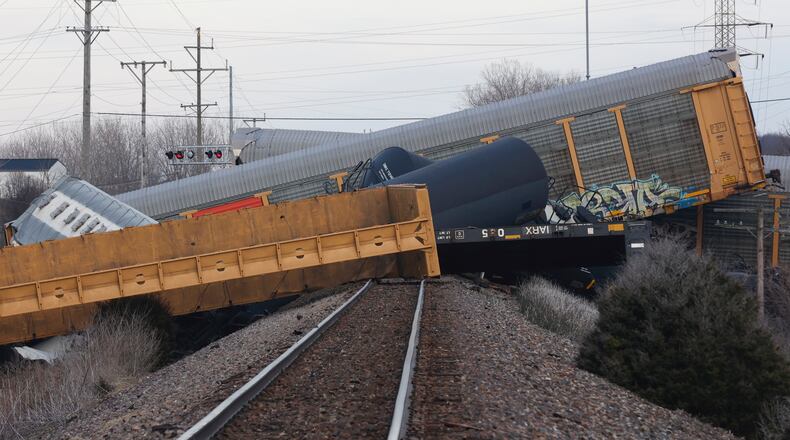Michelle Clements-Pitstick, director of the EMA, said that like with any emergency, the EMA has identified areas for improvement in their response to the derailment.
“EMA is the people that get everybody to the table to say, ‘This is what we have. This is what we’re doing. This is our needs, you know, where we’re at and where we’re going,’” Clements-Pitstick said.
She said train derailments are fairly commonplace, and this was the second Norfolk Southern one in Clark County in less than a year.
Of the 212 train cars, 31 were labeled as carrying hazardous materials, but those cars remained on the tracks and were unaffected.
Three cars carrying residual amounts of hazardous materials once contained two different kinds of acids and pentanes, said Mark McClain, a Cedarville University chemistry professor in March. Pentanes are used to make packing pellets, construction adhesive and more. Pentanes can also be used as a fuel additive.
McClain said another four cars were carrying benzene, which is used to make different kinds of nylon for clothing and containers, laundry detergent and dishwashing products, pesticides and plastics. Nine cars carried liquid petroleum gas, used in cooking and heating. Others contained alcohols.
The reason why the train came off the tracks is not known for sure, but Clements-Pitstick said it is possible it was one of several with loose wheels that were recalled.
The EMA and other safety agencies had just gone through a train derailment simulation the previous year at the same location, Clements-Pitstick said, and this was a huge benefit to everyone involved in the real situation.
Clements-Pitstick said when the EMA sent out a shelter-in-place notice to residents within a certain mile radius, she didn’t include a map until someone asked for one on social media. She said this is something that can be implemented from the start in future emergencies.
Another important aspect of emergency response is extensive pre-planning, and having agencies regularly meet and share their own plans can help in crafting the most effective response, Clements-Pitstick said.
“Pre-planning is the key,” she said. “Being able to talk things through before they happen definitely makes things go smoother when things do. That way you’re not figuring it out on the fly.”
The EMA is always working to improve communication during an emergency, but Clements-Pitstick said a specific improvement in this area would be training first responders to not all clog up the radio updating dispatch on everything they are seeing, which during this incident prevented the incident commander to communicate what he needed everyone to do.
To keep the public better informed, the EMA director said the agency could have held a press briefing while waiting for Ohio Edison to ensure that electric lines were safe to work near. She said they could have told the public what they knew and that there was no real cause for concern sooner.
Clements-Pitstick said the derailment disaster in East Palestine, in which hundreds of thousands of hazardous waste spilled into the air and water, was top of mind for everyone during this response, although the two incidents could not be more different. She the command post for the Springfield Twp. incident had four workstations, all of which were taken up by EMA staff.
“That’s a learning curve for me being a new director — that someone from the EMA can be on scene and be that liaison and report back to anybody that’s in this (EMA) room what’s going on,” Clements-Pitstick said. “Then that would alleviate some extra staff on site that ... was taking up space for other folks that could have been in the command post.”
Clements-Pitstick said the EMA and associated agencies are constantly planning and training for future potential disasters.
“We are very well-trained in this county. We are very fortunate for the equipment that we do have,” she said. “We are very fortunate (for) all our relationships that we have established pre-incident. We have all of those things working for us when bad stuff happens.”
About the Author

